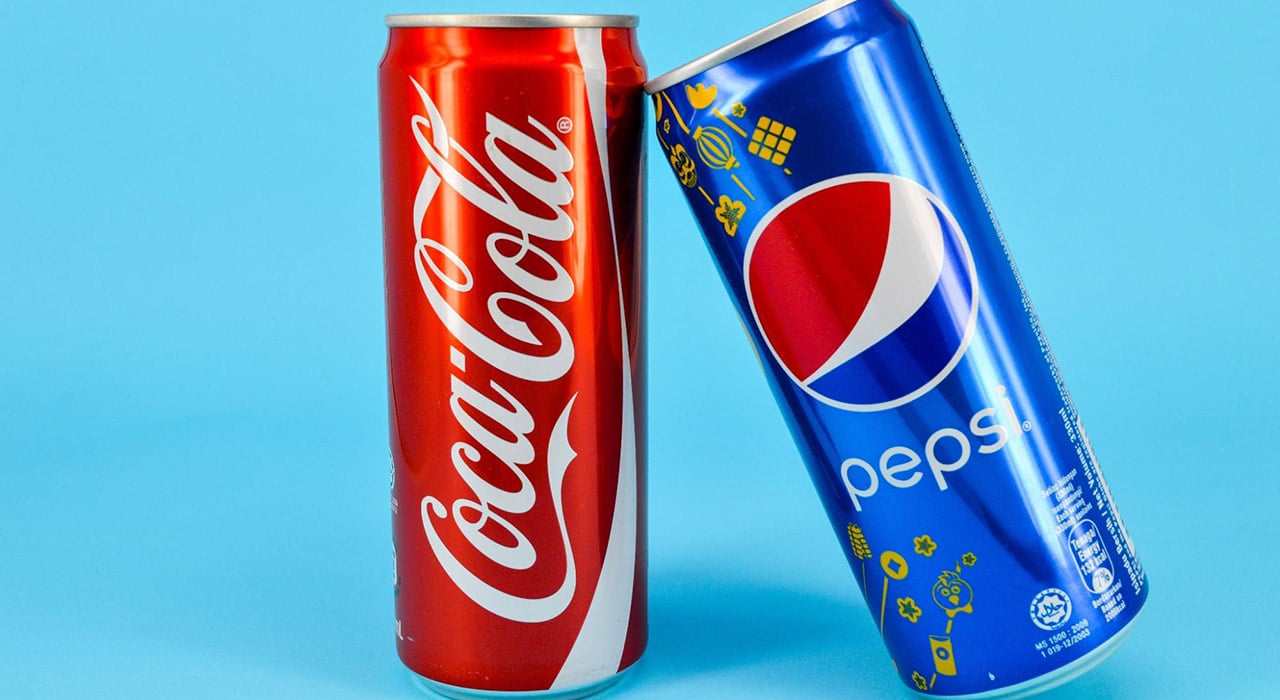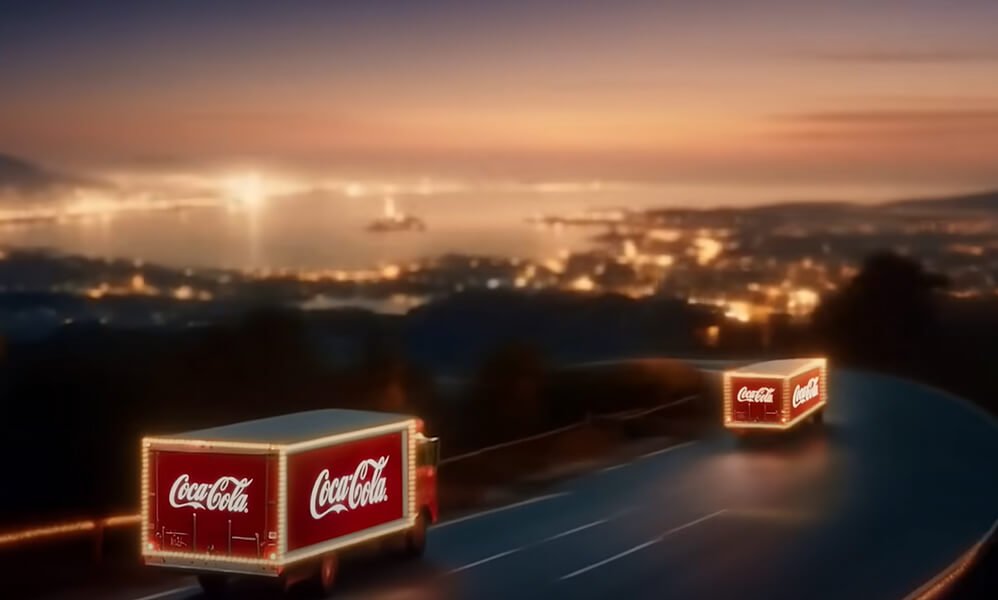
Dan Tull
Copywriter

Brands are often in constant competition with one another. In recent years, with the appropriation of social media and the ability to communicate in real time, these rivalries have become a critical part of the communication strategy. You may have seen the friendly, tongue in cheek banter between market competitors on Twitter (or X) which helps to humanise brands in order to make them relatable to audiences. A great example of this was Aldi Vs M&S in the famous Battle of the Caterpillars.
But there was a time before social media where one of these rivalries was not quite as friendly. A rivalry that was so intense that it caused ripples throughout entire industries that can still be felt today. I am talking, of course, about the Cola Wars of the 1970s…
Meet the combatants
The Cola Wars were fought between two rival soft drink manufacturers, Coca-Cola and Pepsi. Both are household names in today's world, and whilst they still compete for market share, it is nowhere near as intense.
Before the onset of the Cola Wars, Coca-Cola had firmly established itself as a revered and iconic brand. Founded in the late 19th century, Coca-Cola had already become synonymous with American culture and refreshment. Its marketing strategy emphasised timeless values and traditions, often portraying the beverage as a symbol of happiness and togetherness. With its classic formula and distinct branding, Coca-Cola held a dominant position in the soft drink market.
On the other hand, Pepsi, although present in the market, had not yet reached the same level of cultural significance as Coca-Cola. PepsiCo, the parent company, sought to modernise its image and appeal to a younger demographic. Pepsi's marketing campaigns adopted a more youthful and energetic approach, often positioning itself as the choice of the new generation. This laid the foundation for the intense rivalry that would unfold as both brands vied for consumer attention, ultimately giving rise to the Cola Wars.
The Cola Wars were instigated by a combination of factors, including market competition, shifting consumer preferences, and aggressive marketing strategies. The rivalry between Coca-Cola and PepsiCo escalated through a series of events and marketing manoeuvres that heightened tensions between the two beverage giants. It was only a matter of time before these two titans came to blows.
The conflict escalates
One of the earliest escalations occurred in the late 1970s and early 1980s when PepsiCo introduced the "Pepsi Challenge" campaign. This blind taste test challenged consumers to try both Pepsi and Coca-Cola without knowing which was which. Pepsi's marketing claimed that people preferred the taste of Pepsi over Coca-Cola in these blind tests. This campaign effectively drew attention to the taste differences between the two colas and positioned Pepsi as the superior choice.
In response, Coca-Cola, feeling the threat to its market share and brand reputation, decided to reformulate its classic beverage in 1985. The introduction of "New Coke," a sweeter formulation, aimed to match the perceived preferences revealed by the Pepsi Challenge. However, this decision proved to be a major misstep. Consumers were deeply attached to the original Coca-Cola formula and expressed their dissatisfaction with the change. The backlash and public outcry that followed were immense, leading to a short-lived existence of New Coke.
The failure of New Coke led to another pivotal moment in the Cola Wars. Coca-Cola, realising its mistake, reintroduced the original formula as "Coca-Cola Classic." This move was accompanied by a significant marketing campaign that emphasised the heritage and tradition associated with the classic formula. The resurgence of Coca-Cola Classic rekindled brand loyalty and reaffirmed the emotional connection consumers had with the original. Was this a carefully coordinated strategic plan or the quick thinking of shell shocked advertisers? To this day, no one is truly sure.
There is still some debate as to whether this was truly a hostile battle for dominance over market share or a clever joint marketing strategy that boosted both brands. Regardless of the truth, there are lessons to be learned in strategies used in the Cola Wars, some to be repeated, others to be avoided.
What went well?
- Intense Marketing and Advertising: Both Coca-Cola and PepsiCo engaged in aggressive and creative marketing campaigns to capture consumer attention. This led to increased brand visibility and consumer loyalty for both companies.
- Product Innovation: The competition between the two brands drove continuous product innovation. New flavours, packaging sizes, and variations were introduced to cater to changing consumer preferences.
- Global Expansion: The rivalry pushed both companies to expand their presence worldwide, leading to increased market penetration and brand recognition on a global scale.
- Increased Consumption: The fierce competition led to heightened consumer interest and consumption of carbonated beverages in general. The Cola-Wars indirectly contributed to the overall growth of the soft drink industry.
What went less well?
- Negative Perception: At times, the aggressive marketing tactics led to negative public perceptions of both brands, with accusations of unhealthy products and contributing to obesity. This backlash could have long-term effects on brand reputation.
- Cannibalization: The intense competition often led to both companies competing for the same market segments, resulting in potential cannibalization of their own sales and profits.
- Focus on Short-Term Gains: In the pursuit of winning the immediate battle, both companies might have overlooked long-term sustainability and the need to adapt to changing consumer preferences beyond carbonated beverages.
- Legal and Ethical Concerns: The rivalry sometimes led to legal battles and accusations of unethical practices, diverting resources and attention from core business operations.
The Fallout
The Cola Wars left an indelible mark on the soft drink industry, exerting a ripple effect that extended beyond Coca-Cola and PepsiCo. The intense rivalry between these two behemoths sparked a climate of heightened competition and innovation, compelling not only cola producers but also other beverage companies to elevate their game. Witnessing the impact of strategic marketing, product diversification, and global expansion pursued by Coca-Cola and PepsiCo, other companies in the industry recognised the necessity of adapting to changing consumer preferences and the importance of brand loyalty.
Moreover, the focus on health-conscious consumer trends catalysed a shift towards producing healthier beverage options, leading to an industry-wide expansion of low-calorie, sugar-free, and natural drinks. The Cola Wars served as a powerful case study, driving the entire sector to reevaluate their marketing, product development, and consumer engagement strategies, resulting in a more dynamic and responsive soft drink landscape that continues to resonate with evolving market demands.
What can we learn from the Cola Wars?
Modern brands could draw valuable lessons from the Cola Wars and strategically harness the concept of brand rivalry to their advantage. By creating a controlled and engaging competition with a rival, brands can generate heightened consumer interest and increase brand visibility. This rivalry-driven approach could involve innovative marketing campaigns that playfully pit the brands against each other, enticing consumers to actively participate and take sides. There is a level of self-awareness and humour that can be drawn from brands playing with the preconceptions that audiences have about them.
- Healthy Competition Drives Innovation: The Cola Wars demonstrate that healthy competition can drive companies to innovate and create new products to stay relevant and capture market share.
- Balancing Short-Term and Long-Term Goals: While intense rivalry can lead to short-term gains, companies must also focus on long-term sustainability and adaptability to changing market dynamics.
- Brand Image and Perception Matter: Negative perceptions resulting from aggressive marketing or other controversies can have lasting effects on a brand's reputation. Maintaining a positive brand image is crucial.
- Diversification and Adaptation: Companies should not solely rely on a single product or strategy. Diversification and the ability to adapt to changing consumer preferences are key to long-term success.
Emphasising product differentiation and unique selling points in a lighthearted rivalry can showcase a brand's strengths and values while captivating the audience's attention. However, it's crucial for modern brands to maintain ethical conduct and avoid negative tactics that could harm their reputation. By carefully orchestrating a brand rivalry, companies can fuel consumer excitement, encourage healthy engagement, and ultimately strengthen brand loyalty, all while driving innovation and growth within the industry.
When marketers seek to look outside the box for new and disruptive strategies, looking to the past can be a great place to start. Get in touch with us today to talk about your marketing challenges.



